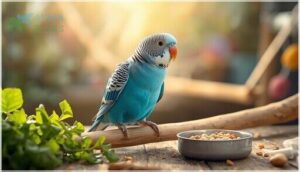This site is supported by our readers. We may earn a commission, at no cost to you, if you purchase through links.

These vibrant companions thrive longer when you provide a balanced diet, spacious cage, regular vet checkups, and mental stimulation.
Wild parakeets face more challenges, living around 4-6 years due to predators and environmental stress.
Your feathered friend’s longevity depends heavily on genetics, nutrition, exercise, and social interaction.
Signs of a healthy, long-lived parakeet include bright eyes, smooth feathers, and active behavior.
The secret to maximizing your bird’s years lies in understanding specific care techniques that many owners overlook.
Table Of Contents
- Key Takeaways
- Origin and Natural Behavior
- Dietary Habits
- Housing and Living Environment
- Cost Considerations
- Behavioral Traits
- Parakeet Lifespan Overview
- Parakeet Age Stages
- Factors Affecting Lifespan
- Oldest Living Parakeet
- Parakeet Health Indicators and Lifespan Averages
- Frequently Asked Questions (FAQs)
- Is a blue parakeet a good pet?
- How long does a blue parakeet live in captivity?
- How can you determine the age of a blue parakeet?
- What are some environmental factors that can impact the lifespan of blue parakeets?
- How do male and female parakeets differ in lifespan?
- Can parakeets live longer in pairs versus alone?
- What are early warning signs of parakeet aging?
- Do different parakeet color mutations affect longevity?
- How does breeding impact female parakeet lifespan?
- Conclusion
Key Takeaways
- Your blue parakeet’s lifespan ranges from 7-15 years with proper care – that’s nearly triple their wild counterparts, who only live 4-6 years due to predators and environmental stress.
- Diet quality directly impacts longevity – you’ll need to provide balanced nutrition, including high-quality seeds, pellets, fresh fruits, and vegetables, rather than relying solely on seeds.
- Environmental factors you control make the difference – proper cage size (18+ inches wide), temperature control (60-70°F), clean air quality, and stress reduction significantly extend your bird’s life.
- Regular veterinary care is essential for maximum lifespan – annual checkups with an avian vet enable early disease detection and preventive care that can help your parakeet reach 15-20 years.
Origin and Natural Behavior
Imagine this: you’re watching a flock of vibrant blue parakeets sweep across the Australian outback, their synchronized movements creating a living kaleidoscope against the vast sky.
Picture thousands of azure wings painting patterns across endless golden horizons—nature’s most spectacular aerial ballet in motion.
These remarkable birds, known as budgerigars in their wild Australia homeland, exhibit fascinating social structures that shape their daily lives.
In their natural bird habitat, blue parakeets live in massive flocks that can number in the thousands, creating complex social interaction networks that help them survive harsh conditions.
Their flight patterns follow seasonal changes, with nomadic movements driven by food availability and weather patterns.
Regarding breeding behaviors, these birds time their reproduction with Australia’s unpredictable rainfall, ensuring their chicks have the best chance of survival.
Their natural diet consists primarily of grass seeds and grains, which they forage from the ground in coordinated group efforts.
Understanding these wild habitats and behaviors helps you appreciate why captive blue parakeets need companionship and mental stimulation to thrive.
They also use various vocalizations and songs to communicate within these flocks.
Dietary Habits
Your blue parakeet’s nutrition directly impacts its lifespan and overall health.
A balanced bird diet combines multiple food sources rather than relying solely on seeds.
Here’s what your parakeet needs:
- Seed Variety – High-quality mixed seeds as the foundation, limited to two tablespoons daily
- Pellet Importance – Specially formulated pellets provide essential vitamins and minerals seeds lack
- Fruit Inclusion – Fresh oranges, apples, and grapes supply necessary nutrients and antioxidants
- Vegetable Benefits – Kale, spinach, and broccoli offer important vitamins for immune support
- Treat Moderation – Millet sprays and nuts occasionally, avoiding sugary or processed foods
This varied nutrition approach supports your blue parakeet lifespan of 7-15 years in captivity.
Housing and Living Environment
Creating the right living space determines whether your blue parakeet thrives or merely survives.
Proper cage dimensions should measure at least 18 inches wide by 18 inches long, with bar spacing around 3/8 inches.
Your bird environment needs perch variety in different diameters and safe location away from drafts.
Cleaning frequency should be several times weekly to prevent respiratory issues.
A suitable cage guarantees adequate space requirements for the parakeet.
Cage Size considerations:
- Freedom to flourish: Adequate space prevents stress-related behaviors and foot injuries
- Room to spread wings: Larger cages allow natural stretching and movement patterns
- Mental stimulation zone: Spacious environments encourage foraging and exploration behaviors
Toy enrichment keeps intelligent minds busy, while varied perch sizes exercise feet naturally.
Your blue parakeet lifespan depends heavily on this foundation.
Cost Considerations
When you’re considering bringing a blue parakeet into your home, it’s important to understand the financial commitment extends well beyond the initial purchase price.
You’ll need to budget for ongoing expenses like quality food, veterinary care, cage maintenance, and potential emergency medical costs that can span their 7-15 year lifespan.
Cost of Parakeet Care
While proper housing sets the foundation for healthy parakeet ownership, understanding the financial commitment helps you prepare for years of companionship ahead.
Your initial investment typically ranges from $150 to $350, covering the parakeet price ($20-$60), bird cage ($50-$150), and essential accessories. However, recurring expenses add up quickly—monthly parakeet food costs $10-$25, while annual veterinary care averages $50-$100. Consider how different brands affect overall parakeet food expenses.
Smart budgeting includes these key areas:
- Emergency funds for unexpected health issues exceeding $200
- Insurance options with premiums around $10-$20 monthly
- Cost-saving tips like bulk purchasing quality parakeet food
- Preventive veterinary care to avoid costly treatments later
Remember, parakeet care spans 7-15 years, so lifetime costs reach $2,000-$4,000 per bird.
Budgeting for Parakeets
When budgeting for your blue parakeet, smart spending strategies can substantially reduce parakeet price and ongoing expenses.
Start with used cages from classified ads or pet stores, saving 30-50% compared to new ones. Create DIY enrichment using toilet paper rolls and cardboard instead of expensive toys.
Buy cheap food in bulk, focusing on quality seeds and pellets. Find discount vets through local bird clubs or veterinary schools. Affordable cage options are readily available online.
Set aside $20-30 monthly for routine care, plus emergency funds for unexpected health issues. Affordable toys like mirrors and swings keep your bird happy without breaking the bank, utilizing DIY enrichment and quality seeds for a happy and healthy pet, with emergency funds for any unexpected issues.
Financial Considerations for Parakeets
Planning your parakeet’s financial future requires smart budgeting beyond the initial cost.
Your feathered friend’s ongoing expenses can surprise first-time owners, but with proper planning, you’ll avoid financial stress.
Consider these key financial factors:
- Initial setup costs – Quality cages, perches, and toys require upfront investment but last years
- Monthly ongoing expenses – Food, bedding, and cleaning supplies add up to $15-30 monthly
- Veterinary budgeting – Annual checkups cost $50-150, with emergency visits potentially reaching $300-500
Insurance options for birds remain limited, making DIY savings accounts smart.
Many pet care guides recommend setting aside $20 monthly for unexpected veterinary advice needs.
Behavioral Traits
Understanding your blue parakeet’s behavioral traits will help you create a better environment for their wellbeing.
These intelligent birds are natural chatterboxes, using vocalizations to communicate and often mimicking sounds they hear around the house.
Their playfulness shines through constant activity—climbing, swinging, and exploring their surroundings.
Social interaction is essential since parakeets are flock animals who crave companionship, whether from other birds or their human family.
Training techniques work well with their intelligence, as they can learn tricks and words with patience and repetition.
Parakeets in flocks benefit from shared vigilance against predators, which is crucial for their survival and overall health.
Parakeet Lifespan Overview
Your blue parakeet’s lifespan depends on several key factors that you can influence through proper care. Most captive parakeets live 7-15 years, with an average lifespan of 10-12 years when given adequate attention.
This dramatically exceeds their wild counterparts, who typically survive only 4-6 years due to predation and environmental challenges. The difference between wild vs. captive longevity shows how your care directly impacts your bird’s lifespan potential.
Exceptional cases have reached 20+ years, with the oldest recorded parakeet living to 29 years according to Guinness World Records.
Several longevity factors determine whether your parakeet reaches the upper end of this range:
- Quality of daily care: Consistent nutrition, clean housing, and regular health monitoring form the foundation of extending lifespan.
Your parakeet’s genetics play a role, but environmental factors within your control matter more.
Stress reduction, proper socialization, and preventive veterinary care substantially boost bird lifespan expectations, making the difference between a short life and reaching full longevity potential.
Parakeet Age Stages
Your blue parakeet’s journey unfolds through distinct life stages, each with unique characteristics.
Hatchling Development begins around 6 weeks, when curiosity drives exploration.
The Juvenile Stage (6 weeks to 6 months) showcases bold energy and learning.
Adult Behavior emerges from 6 months to 2½ years, featuring confidence and social bonding.
Senior Care becomes important as middle-aged birds (2½+ years) show decreased activity and longer naps.
End-of-Life signs include reduced appetite and mobility, requiring gentle, compassionate attention during their final days.
Factors Affecting Lifespan
Your parakeet’s lifespan isn’t just about luck—it’s largely determined by how well you care for them.
Several key factors can either extend your bird’s life toward the 15-20 year range or cut it short, making proper care decisions essential for maximizing their longevity.
Environmental Factors and Lifespan
Your blue parakeet’s environment directly impacts their lifespan and longevity.
Proper cage size, ideally 18 inches wide, allows natural movement that wild birds enjoy.
Temperature control between 60-70°F, good air quality, and moderate noise levels create ideal conditions.
Light exposure should mimic natural cycles, and these environmental factors can extend your bird’s life from the typical wild vs captivity difference, potentially reaching 15+ years with careful attention.
Importance of Proper Diet
Above and beyond poor housing, your blue parakeet’s diet serves as the foundation for longevity.
Nutrient deficiency from seed-only diets shortens lifespan substantially.
Balanced nutrition requires dietary variety including pellets, fresh fruits, and vegetables.
Avoid toxic foods like avocado and chocolate.
Quality bird nutrition with proper supplement needs guarantees your parakeet thrives for years with balanced nutrition.
Role of Veterinary Care
Annual checkups with an avian veterinarian serve as your blue parakeet’s health insurance policy.
These visits enable early detection of hidden illnesses, since parakeets instinctively mask symptoms.
Your vet will perform parasite control screenings and provide disease prevention guidance.
Regular exams also allow for early disease detection, which is critical for a long and healthy life.
Emergency care becomes less likely when you maintain consistent bird veterinary care, directly extending your parakeet lifespan through proactive bird health management.
Oldest Living Parakeet
Charlie the budgerigar made history by reaching 29 years and 2 months, earning a Guinness Record as the oldest verified parakeet.
Charlie proved that with exceptional care, parakeets can live nearly three decades – almost triple the typical lifespan.
Most blue parakeet owners can expect their birds to live 7-10 years, making Charlie’s longevity** truly remarkable.
Record verification required extensive documentation through veterinary records and witness statements.
Charlie’s owner, Miss J Dinsey from London, provided exceptional care that contributed to these longevity secrets:
- High-quality balanced diet with proper nutrition
- Regular veterinary check-ups and health monitoring
- Clean, stress-free living environment
- Consistent daily care routine
- Genetic factors that supported extended lifespan
Charlie’s case demonstrates your parakeet’s potential when you provide ideal bird care.
A key factor is providing a clean and spacious cage.
While reaching nearly three decades isn’t typical, understanding these factors can help extend your feathered friend’s parakeet lifespan.
Exceptional care doesn’t guarantee record-breaking longevity, but it substantially improves your blue parakeet’s chances of living a full, healthy life.
Parakeet Health Indicators and Lifespan Averages
Several key health indicators reveal your blue parakeet’s well-being and potential longevity. Bright, clear eyes without discharge signal good avian health, while smooth, vibrant feathers indicate proper nutrition.
You’ll notice healthy parakeets maintain active movement, alert posture, and consistent vocalizations throughout the day. Monitor your bird’s droppings daily – they should show green-brown fecal portions, white urates, and clear urine.
Any changes in color, consistency, or frequency often indicate digestive issues that impact parakeet lifespan. Clean vent areas and normal perching behavior reflect overall wellness.
Average longevity for blue parakeets ranges 7-15 years in captivity, nearly double their wild counterparts’ 4-6 years. Disease impact substantially affects these numbers, making veterinary importance vital for extending lifespan.
Lifespan factors include balanced nutrition, spacious housing, and regular health monitoring. Watch for warning signs like fluffed feathers, tail bobbing, or decreased appetite – these suggest illness requiring immediate attention.
Regular weekly weight checks can also help detect early signs of illness. Consistent health indicators and preventive care help maximize your parakeet’s lifespan potential.
Frequently Asked Questions (FAQs)
Is a blue parakeet a good pet?
What if your feathered friend could live up to 15 years with proper care?
Blue parakeets make excellent pets—they’re intelligent, social, and relatively easy to maintain.
You’ll need a spacious cage, balanced diet, and regular vet visits for peak health.
How long does a blue parakeet live in captivity?
Your blue parakeet will typically live 7-15 years in captivity, with proper care extending their lifespan to potentially 20 years or more through quality nutrition and veterinary attention.
How can you determine the age of a blue parakeet?
Like decoding a mystery from scattered clues, you’ll examine head stripes, cere color, and eye pigmentation to gauge your bird’s age.
Juveniles under three months display head stripes extending to their beaks, while young budgies have all-black eyes that develop brown irises with age .
What are some environmental factors that can impact the lifespan of blue parakeets?
Temperature extremes, poor air quality, drafts, overcrowding, inadequate lighting, and high stress levels can substantially shorten your parakeet’s life.
You’ll want to maintain consistent temperatures between 60-70°F while ensuring proper ventilation and spacious housing.
How do male and female parakeets differ in lifespan?
In terms of longevity, female and male parakeets aren’t cut from the same cloth.
Females typically live shorter lives due to egg-laying complications, reproductive stress, and calcium deficiency issues.
Males generally enjoy longer lifespans since they don’t face these breeding-related health challenges throughout their lives, allowing them to live a relatively longer life.
Can parakeets live longer in pairs versus alone?
Yes, parakeets typically live longer in pairs than alone. Companionship reduces stress, provides social interaction, and encourages natural behaviors that support overall health and wellbeing, extending their lifespan.
What are early warning signs of parakeet aging?
Watch for decreased activity, changes in posture, labored breathing, reduced appetite, and altered sleep patterns.
You’ll notice your parakeet becoming quieter, spending more time on cage bottom, and showing less interest in social interaction.
You’ll also observe changes such as your parakeet being quieter and showing less interest in activities.
Do different parakeet color mutations affect longevity?
Research shows no significant lifespan differences between color mutations.
Blue, green, yellow, and other variations typically live 7-15 years with proper care.
Color doesn’t affect genetics related to longevity—diet, housing, and veterinary care remain the key factors.
How does breeding impact female parakeet lifespan?
Breeding substantially impacts female parakeet lifespan through reproductive stress. Chronic egg laying depletes calcium reserves, weakens bones, and can cause life-threatening complications like egg-binding, reducing your bird’s longevity.
Conclusion
Like a well-tended garden that flourishes with consistent care, your blue parakeet’s lifespan depends on the attention you provide daily.
Understanding blue parakeet lifespan factors empowers you to give your feathered companion the best possible life.
You’ll maximize their years through proper nutrition, regular veterinary checkups, and creating an enriching environment.
Remember that genetics play a role, but your dedication to quality care makes the biggest difference in helping your parakeet reach their full potential of 15-20 years.
- https://www.petsmont.com/blogs/pets/blue-parakeet-everything-you-need-to-know
- https://articles.hepper.com/parakeet-lifespan-how-long-do-they-live/
- https://worldbirds.com/how-long-do-parakeets-live/
- https://www.zumalka.com/blogs/blog-pet-health/vet-insights-common-parakeet-health-problems
- https://www.linkedin.com/pulse/parakeet-lifespan-how-help-them-live-long-healthy-life-leo-roux













